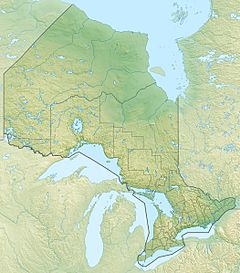Big Willow River facts for kids
Quick facts for kids Big Willow River |
|
|---|---|
|
Location of the river mouth in Ontario
|
|
| Country | Canada |
| Province | Ontario |
| Region | Northwestern Ontario |
| District | Kenora |
| Physical characteristics | |
| Main source | 42 m (138 ft) 52°19′41″N 82°24′37″W / 52.32806°N 82.41028°W |
| River mouth | James Bay 0 m (0 ft) 52°40′41″N 81°53′29″W / 52.67806°N 81.89139°W |
| Basin features | |
| River system | James Bay drainage basin |
The Big Willow River is a cool river located in the northern part of Ontario, Canada. It flows through a region known as Kenora District. This river is an important waterway because it eventually empties into James Bay, a large body of water that is part of the Arctic Ocean.
Contents
Discover the Big Willow River
The Big Willow River is a natural wonder in Northwestern Ontario. It's a great example of the many rivers that help shape the Canadian landscape. Understanding rivers like this helps us learn about geography and the environment.
Where the River Begins
The Big Willow River starts in a special kind of wetland called a muskeg. A muskeg is like a swampy area with lots of moss and peat. It's a unique environment where the river's journey begins.
The River's Journey to James Bay
From its starting point, the Big Willow River flows mainly towards the north-northeast. It travels through the landscape until it reaches its final destination: James Bay. This journey connects the inland areas of Ontario to the vast waters of the bay.
What is James Bay?
James Bay is a large bay located at the southern end of Hudson Bay. It's an important area for wildlife and has a unique ecosystem. The Big Willow River is one of many rivers that contribute water to this significant bay.


